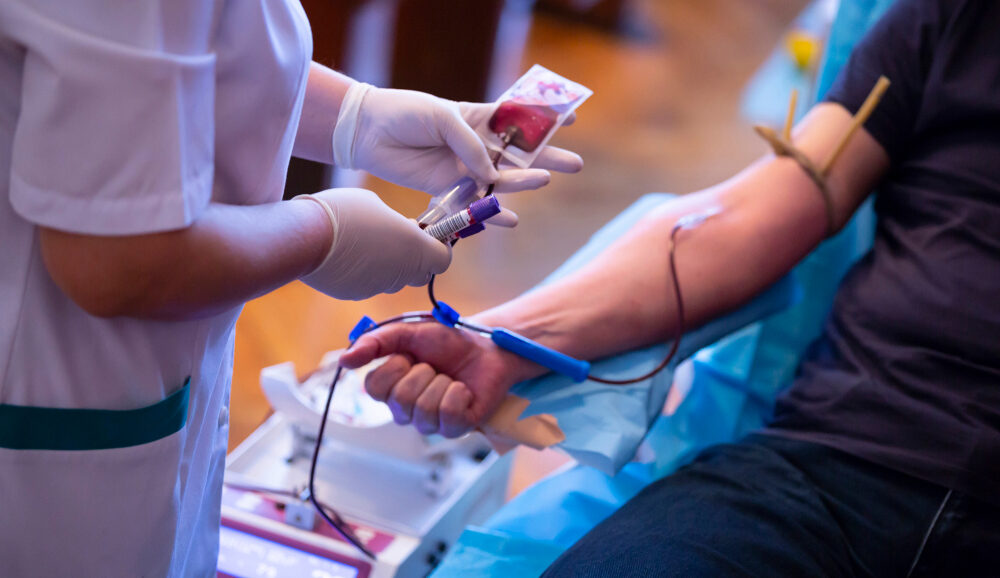In a reversal of a decades-long practice that many in the LGBTQ+ community labeled discriminatory, Stanford Blood Center (SBC) will join others around the U.S. in implementing a new policy making it easier for gay and bisexual men, and women who have sex with bisexual men, to donate blood.
When AIDS emerged in the early 1980s, federal law prevented gay and bisexual men from donating blood because of their risk of HIV, which can be transmitted by transfusion. Over the years that restriction was gradually relaxed, taking into consideration the timing of an individual's last sexual contact.
Now, under new guidance issued by the U.S. Food and Drug Administration last May, blood centers nationwide must treat all potential donors equally, screening them for HIV risk factors based on the same criteria. Stanford will implement the policy on Oct. 19. "This policy eliminates time-based deferrals and screening questions specific to men who have sex with men (MSM) and women who have sex with MSM," the FDA announced in May.
The guidelines follow policies already in place in the United Kingdom and Canada (the UK's policy went into effect in 2021; Canada's in 2022). The FDA maintains that the new policy will continue to ensure the safety of the nation's blood supply while enlarging the pool of potential donors.
The initiative comes at a time when there is an urgent need for blood in the aftermath of the COVID epidemic, when donations significantly declined. Opening up donation to as many people as possible - while still ensuring the safety of the blood supply - will encourage a more robust base of donors and help to ensure there will be enough blood products available for local patients when they need it.
Suchi Pandey, MD, chief medical officer at Stanford Blood Center, has watched this process closely. SBC was part of a study showing that leveling the donor eligibility field would not jeopardize safety. As the SBC implemented the new policy Oct. 19, Pandey discussed the importance of the policy change in terms of equity and how it will impact the local blood supply.
Why is this new policy important?
This a major step forward in bringing inclusiveness to our donor screening process. It is basing eligibility and donor deferrals due to high-risk behavior on an individual assessment, regardless of a donor's gender or sexual orientation. All donors will be asked the same set of questions about sexual behavior. It's a more equitable approach, while also maintaining the safety of the blood supply.
Why now? What has changed?
Data from the ADVANCE (Assessing Donor Variability and New Concepts in Eligibility) study completed at the end of 2022 was a major factor in making this change. The ADVANCE study was designed to assess the viability of questions that could be added to the donor history questionnaire which would allow the U.S. to move to a more individual risk-based approach. Also, very importantly, the change was driven by the experience of countries like the UK and Canada who have adopted a similar approach.
Data from these countries shows that making this change does not pose a risk to blood safety. The change is also supported by extensive data collected by the FDA's national surveillance system that evaluates the rate of HIV and hepatitis in blood donors before and after policy changes. Ultimately, with this data and the advancements in blood donor testing, the FDA was able to move to a more equitable and fair donor selection process in the U.S.
Was Stanford Blood Center involved in advocating for the policy change?
Stanford Blood Center, and blood centers across the country, have been working with the FDA on the deferral policies and strongly supporting research that could look at different ways of assessing eligibility. Stanford has been involved for many years in asking the FDA to evaluate the efficacy of banning deferrals and seeing if there was a strategy that would be more inclusive but also safe. SBC was one of four centers involved in the ADVANCE study, so we had a direct role in one of the groundbreaking studies that led to this change. We also have had representatives who have sat in on meetings on Capitol Hill advocating for prioritizing this issue for several years.
What has been the response from the gay community to the new policy?
The response has been positive -- that this is a step in the right direction. You're not being asked questions because of your sexuality or gender. I think the LGBTQ+ community is supportive of that kind of approach. It will allow certain individuals to donate without restrictions.
Understandably there are concerns around the deferral requirement for PrEP (pre-exposure prophylaxis to prevent HIV transmission). Individuals taking oral PrEP will be deferred for three months from the last dose and two years for injectable PrEP.
It's important to understand why the FDA has implemented the deferral for PrEP. PrEP is an excellent and important public health measure to reduce the sexual transmission of HIV. The challenge with PrEP is that it does such a good job of keeping the viral levels low that it can take a longer time for HIV tests to turn positive if someone does become infected.
This means you can get a false negative on a donor screening test. The FDA will continue to evaluate this issue and possible changes to the PrEP deferral may be released in the future. Blood centers and the FDA recommend that individuals do not stop or delay taking a prescribed medication in order to donate blood.
How will you monitor the impact of the new policy?
We will look at how many people are being deferred and how many more donors we are seeing. We want to understand how the change is impacting people. And, of course, we always monitor our infectious disease rates.
Overall, I expect we will see more donors. We have the potential to see an increase in donor visits as more people donate who couldn't before. And we always need blood.
I think this new strategy of screening all donors with these same questions is a very safe one. It's important for people to realize we have multiple layers of safety. For instance, we still test every donor with very advanced testing platforms for HIV and hepatitis. When you combine all these measures, you can be sure the blood supply will continue to be safe.
Photo: Belish






